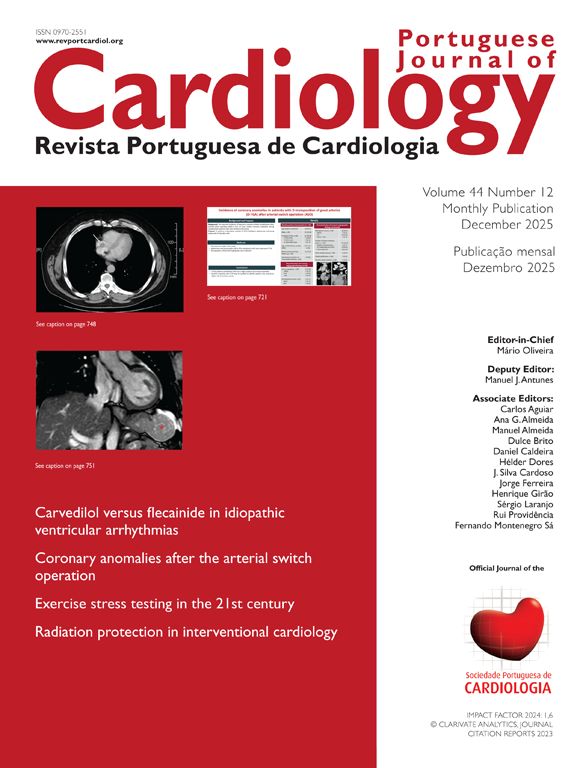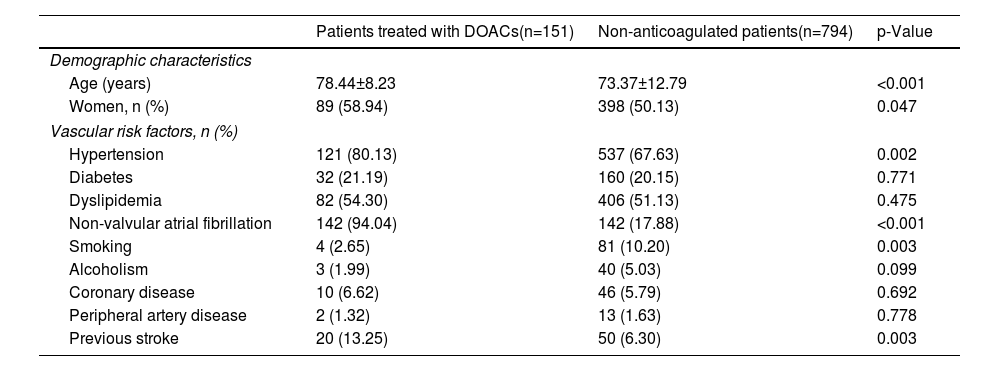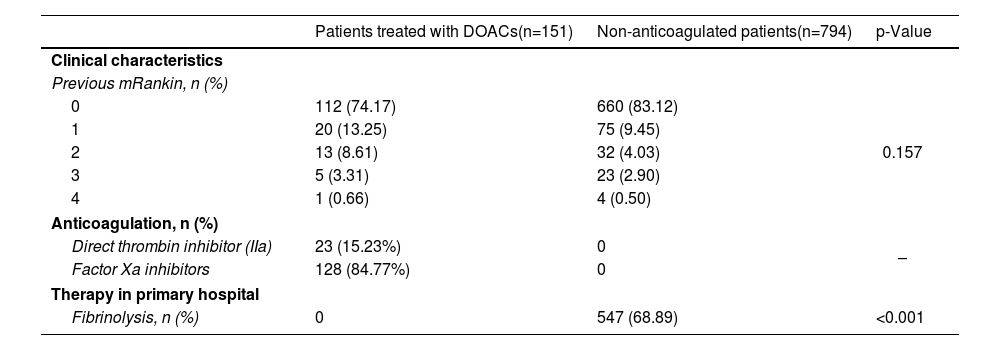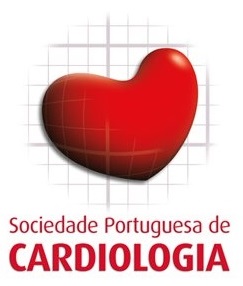Regional telestroke networks offer several advantages, including upstream selection of thrombectomy candidates. However, it is unclear whether the network performance and the functional outcome of patients with ischemic stroke treated with direct oral anticoagulants and transferred to thrombectomy differ from those of non-hypocoagulated patients.
To compare the time metrics and the functional status of patients with ischemic stroke treated with direct oral anticoagulants and transferred to thrombectomy with non-hypocoagulated patients.
MethodsThis was a retrospective multicenter cohort study involving the eight hospitals involved a regional telestroke network. Clinical, imaging and time measures data were obtained from patients transferred for thrombectomy in the period between 01 January 2016 and 18 March 2021. Reperfusion was assumed for modified Thrombolysis in Cerebral Infarction scores 2b and 3. Functional status was assessed using the modified Rankin scale at 90 days.
ResultsOf the 4341 patients evaluated in teleconsultation, 945 patients were transferred for thrombectomy and 15.98% had been previously treated with direct oral anticoagulants. There was no statistically significant difference between groups in the time interval, measured in minutes, between admission to the primary and tertiary hospital (231.59 versus 235.71, p=0.805) and, in patients undergoing thrombectomy, between admission to the tertiary hospital and reperfusion (100.45 versus 102.79, p=0.789). The reperfusion rate did not differ between groups (86.64% versus 83.57%, p=0.625). The functional outcome was not affected by direct oral anticoagulants intake (odds ratio 1.04 [95% confidence interval 0.69–1.55], p=0.857).
Conclusion(s)Treatment with direct oral anticoagulants did not have an impact on the performance or the functional outcome of ischemic stroke patients transferred for thrombectomy.
As redes regionais para abordagem do acidente vascular cerebral agudo oferecem vantagens, incluindo seleção dos candidatos a trombectomia. Não é claro se o desempenho da rede e o desfecho funcional dos doentes com acidente vascular cerebral isquémico, tratados com anticoagulantes orais diretos e transferidos para trombectomia, é diferente dos não anticoagulados.
Avaliar as métricas de atuação e resultados funcionais dos doentes com acidente vascular cerebral isquémico transferidos para trombectomia tratados com anticoagulantes orais diretos em comparação com os doentes não hipocoagulados.
MétodosEstudo coorte histórico multicêntrico envolvendo os oito hospitais da Rede Regional. Colhidos dados clínicos, imagiológicos e medidas de atuação dos doentes submetidos a teleconsultas no período entre 01/01/2016 e 18/03/2021 e transferidos para trombectomia. Assumida recanalização para pontuações 2b e 3 no modified Thrombolysis in Cerebral Infarction. O estado funcional foi avaliado pela modified Rankin scale aos 90 dias.
ResultadosAvaliados 4341 doentes em teleconsulta, 945 foram transferidos para realização de trombectomia; 15,98% dos doentes encontravam-se sob anticoagulantes orais diretos. Não se verificou uma diferença estatisticamente significativa entre grupos no intervalo de tempo, medido em minutos, admissão nos hospitais primário e terciário (231,59 versus 235,71, p = 0,805) e, nos doentes submetidos a trombectomia, entre a admissão no hospital terciário e a recanalização (100,45 versus 102,79, p = 0,789). A taxa de recanalização não diferiu entre os grupos (86,64% versus 83,57%, p = 0,625). O desfecho funcional não foi afetado pela toma de anticoagulantes orais diretos (OR 1,04 [IC95%, 0,69-1,55], p = 0,857).
ConclusãoA anticoagulação com anticoagulantes orais diretos não influenciou as métricas de atuação e o desfecho funcional nos doentes transferidos para trombectomia.
Stroke is the leading cause of morbidity and functional disability and the second leading cause of mortality in Europe.1-3 As the population ages, an increase in incidence and prevalence is expected in the coming decades. Despite favorable developments in recent years in primary prevention, secondary prevention and acute phase treatment, stroke remains the leading cause of mortality in Portugal.4 In the acute phase, rapid and standardized intervention is essential to increase the likelihood of a good functional outcome. It requires proper recognition of stroke signs and symptoms in the community, pre-hospital care, transportation to the hospital, prompt medical evaluation and imaging, and initiation of targeted treatment (with transfer to a referral center, if necessary). Early therapeutic intervention is crucial to minimize the probability of irreversible damage and reduce the impact of stroke morbidity and mortality.5-8
Thrombolysis and thrombectomy are first-line recanalization options in eligible patients with acute ischemic stroke.6-11 Thrombectomy is the only reperfusion treatment available for anticoagulated patients with large vessel occlusion and those in whom intravenous tissue plasminogen activator is contraindicated. Despite their importance in primary and secondary stroke prevention in patients with non-valvular atrial fibrillation (NVAF), the prescription of direct oral anticoagulants (DOACs) has implications for acute-phase therapy. At the time of the study, two groups of DOACs were available in Portugal: factor Xa inhibitors (edoxaban, apixaban, and rivaroxaban) and direct thrombin inhibitors (dabigatran).
The management of patients with ischemic stroke in an emergency context admitted to a primary hospital varies depending on the medication they had taken previously. Thrombolysis is contraindicated in patients who have taken DOACs in the preceding 48 hours and indicated in the rest (excluding other contraindications). Nevertheless, it is unknown whether the functional outcome is different, as the second group initiates reperfusion treatment later at the tertiary hospital.
Regional networks have been developed in recent decades. The central Portugal regional network was created in August 2015 and plays a fundamental role in managing the acute phase of stroke. Regional organizational models for acute stroke management using telemedicine offer several advantages, including upstream selection of thrombectomy candidates.12-15 However, it is unclear whether the performance of the telestroke network and the functional outcome of patients with ischemic stroke treated with DOACs and transferred for primary endovascular intervention differ from those of other patients.
ObjectivesThe objective of this study was, therefore, to evaluate the performance metrics and functional outcome of patients with ischemic stroke transferred for endovascular intervention within a regional network treated with DOACs compared to those not anticoagulated.
MethodsRegional Stroke Fast Track Network (Via Verde do AVC regional)The Regional Stroke Fast Track Network in central mainland Portugal is based on a “drip and ship” model in line with European recommendations and includes seven primary hospitals and one tertiary hospital. Patients are assessed at the nearest hospital capable of performing thrombolysis (“stroke ready hospitals”). When a patient with suspected acute stroke is admitted to a primary hospital, the case is immediately presented to the neurologist responsible for the stroke unit at the tertiary hospital via a teleconsultation. The results of imaging tests (cranial computed tomography (CT) and cranial and cervical CT angiography, if necessary) are analyzed by a multidisciplinary team using specific software, and if indicated, immediate initiation of thrombolysis and/or emergent transfer for endovascular treatment is proposed. Transportation is provided by the National Institute of Medical Emergency.
Study proceduresA retrospective multicenter observational study was conducted, including the eight hospitals of the Regional Stroke Fast Track Network in the central region of mainland Portugal. Clinical and imaging data were obtained from patients evaluated via teleconsultation with a diagnosis of ischemic stroke due to large vessel occlusion, initially admitted to network primary hospitals and subsequently transferred for thrombectomy, between 01 January 2016 and 18 March 2021. Patients under 18 years old were excluded. Information regarding DOAC prescription and therapeutic adherence was collected from the patients themselves, informants, and from clinical records. Performance metrics and functional outcomes were recorded. Whenever symptom onset was witnessed, the precise time reported by the informant was used. In other cases, the time when the patient was last seen well (LSW) was considered. The intervals between symptom onset/LSW and admission to the primary hospital, admission to primary and tertiary hospitals, and, in patients undergoing thrombectomy, between admission to the tertiary hospital and recanalization were expressed in minutes. Recanalization was assumed for modified Thrombolysis in Cerebral Infarction score (mTICI) scores 2b and 3. Functional outcome was assessed using the modified Rankin scale (mRS) at 90 days. Assessment was conducted in-person whenever possible or by telephone by the responsible physician. Data were collected anonymously, and the research protocol was approved by the ethics committee.
Statistical analysisCategorical variables were presented as frequencies and percentages and continuous variables were expressed as means and standard deviations. Descriptive and comparative analysis of network performance and functional outcomes between patients treated with DOACs and non-anticoagulated patients were conducted. Statistical analysis included univariate and multivariate analysis adjusted for potential confounding variables. Statistical significance was assumed for p<0.05.
ResultsSample characterizationDuring the study period (01 January 2016 to 18 March 2021), 4341 patients were evaluated via teleconsultation. Of these, 945 were transferred for thrombectomy, with a mean age of 74.14±12.32 years; 51.53% were women. Demographic characteristics and vascular risk factors are summarized in Table 1. There was no statistically significant difference in demographic characteristics and vascular risk factors, except for: age, sex, hypertension, NVAF, smoking, and previous stroke. These variables were included as confounding variables in multivariate analysis. Of the total sample, 151 patients (15.98%) were taking DOACs, of whom 128 patients (84.77%) were medicated with factor Xa inhibitors and 23 patients (15.23%) with direct thrombin inhibitor. Among non-anticoagulated patients, 547 (68.89%) underwent thrombolysis. None of the anticoagulated patients underwent thrombolysis. Table 2 summarizes the characteristics regarding the degree of prior autonomy of the two groups, type of anticoagulation therapy and treatment in the primary hospital.
Demographic characteristics and vascular risk factors of the study population.
| Patients treated with DOACs(n=151) | Non-anticoagulated patients(n=794) | p-Value | |
|---|---|---|---|
| Demographic characteristics | |||
| Age (years) | 78.44±8.23 | 73.37±12.79 | <0.001 |
| Women, n (%) | 89 (58.94) | 398 (50.13) | 0.047 |
| Vascular risk factors, n (%) | |||
| Hypertension | 121 (80.13) | 537 (67.63) | 0.002 |
| Diabetes | 32 (21.19) | 160 (20.15) | 0.771 |
| Dyslipidemia | 82 (54.30) | 406 (51.13) | 0.475 |
| Non-valvular atrial fibrillation | 142 (94.04) | 142 (17.88) | <0.001 |
| Smoking | 4 (2.65) | 81 (10.20) | 0.003 |
| Alcoholism | 3 (1.99) | 40 (5.03) | 0.099 |
| Coronary disease | 10 (6.62) | 46 (5.79) | 0.692 |
| Peripheral artery disease | 2 (1.32) | 13 (1.63) | 0.778 |
| Previous stroke | 20 (13.25) | 50 (6.30) | 0.003 |
Clinical characteristics, anticoagulation and acute-phase therapy in the primary hospital of the study population.
| Patients treated with DOACs(n=151) | Non-anticoagulated patients(n=794) | p-Value | |
|---|---|---|---|
| Clinical characteristics | |||
| Previous mRankin, n (%) | |||
| 0 | 112 (74.17) | 660 (83.12) | 0.157 |
| 1 | 20 (13.25) | 75 (9.45) | |
| 2 | 13 (8.61) | 32 (4.03) | |
| 3 | 5 (3.31) | 23 (2.90) | |
| 4 | 1 (0.66) | 4 (0.50) | |
| Anticoagulation, n (%) | |||
| Direct thrombin inhibitor (IIa) | 23 (15.23%) | 0 | – |
| Factor Xa inhibitors | 128 (84.77%) | 0 | |
| Therapy in primary hospital | |||
| Fibrinolysis, n (%) | 0 | 547 (68.89) | <0.001 |
mRankin: modified Rankin scale.
There was no statistically significant difference between patients treated with DOACs and non-anticoagulated patients in the time interval, measured in minutes, between symptom onset/LSW and admission to the primary hospital (158.87 versus 188.77, p=0.124), admission to primary and tertiary hospitals (231.59 versus 235.71, p=0.805), and in patients undergoing thrombectomy, between admission to the tertiary hospital and recanalization (100.45 versus 102.79, p=0.789).
Recanalization rate and functional outcomeThe recanalization rate (final mTICI 2b and 3) did not differ significantly between patients treated with DOACs and non-anticoagulated patients (86.64% versus 83.57%, p=0.625); the functional outcome at three months was not affected by DOAC intake (OR 1.04 [95% CI 0.69–1.55], p=0.857). A similar percentage of patients achieved functional independence (43% versus 45%). There was a lower percentage of patients with mRS 0 (7% versus 14%) and a higher percentage with mRS 2 (19% versus 13%) in the DOAC group. Mortality was similar between the groups (19% versus 18%) – Figure 1.
DiscussionAs expected, some demographic characteristic and vascular risk factors age, sex, hypertension, NVAF, smoking, and previous stroke) differed significantly among the study groups. In our sample, patients on DOACs were older, more often female, had a higher prevalence of hypertension, NVAF, and previous stroke, and a lower prevalence of smoking. These differences may reflect the epidemiological differences in various vascular risk factors and the main etiologies of stroke, notably the increased prevalence of NVAF (most frequent reason for DOAC introduction) with age and in patients with hypertension or smoking-associated atherothrombotic stroke. The interval between symptom onset/LSW and admission to the primary hospital was greater than 120 minutes in both groups, and no statistically significant difference was identified. Multiple factors contribute to this time interval (identification of stroke signs and symptoms by the patient and the community, activation of pre-hospital emergency services, and distance to the primary hospital). However, the absence of a statistically significant difference may suggest that anticoagulated patients (mostly due to NVAF) and their families are not more aware than the general population of stroke signs and/or symptoms. It is important to note that some of the data are from the period of the SARS-CoV-2 pandemic, which influenced the temporal metrics of the Regional Stroke Fast Track Network in the Central Region of Portugal. In the general population, knowledge about stroke is insufficient. Previous studies have shown that a small percentage of patients contact emergency medical services within the first hour after stroke symptom onset, and less than half recognize stroke as the etiology of their symptoms. These results demonstrate the importance of community awareness programs. The follow-up of patients with NVAF represents an opportunity to alert patients and their families to recognize and act in case of stroke. Medical consultations are an opportunity to promote health education: cardiologists, neurologists, internists, general practitioners, among others, play a fundamental role in promoting primary and secondary prevention, including lifestyle modification and control of modifiable vascular risk factors. The absence of statistically significant differences in the time intervals between admission to primary and tertiary hospitals and between admission to the tertiary hospital and recanalization may reflect uniformity in the actions of the teams involved at the intra and inter-hospital levels. Regarding the interval between admission to primary and tertiary hospitals, it can be inferred that, in the case of patients meeting the criteria for thrombolysis, the procedure does not delay the transfer process, as it is mostly performed during the activation period of the inter-hospital transfer team. The interval between admission to the tertiary hospital and recanalization did not differ between the groups, as the recanalization rate did. The role of DOACs in the recanalization process needs to be clarified. The analysis of functional outcome at 90 days shows the absence of influence of DOAC medication on the three-month functional outcomes (including mortality) in patients with ischemic stroke and large vessel occlusion transferred for thrombectomy. Patients on DOACs had a similar functional outcome to other patients despite not undergoing intravenous thrombolysis at the primary hospital.
This study has limitations: it is a retrospective study whose data were collected from clinical records that were sometimes incomplete. In addition, the calculation of mRS was evaluated by experienced professionals, but not all with formal certification. The results of this study cannot be extrapolated to other regions due to different protocols of action.
ConclusionDespite the different approach in acute phase treatment, anticoagulation with DOACs did not influence performance metrics and functional outcome at three months in ischemic stroke patients transferred for thrombectomy.
Learning points- •
The intake of direct oral anticoagulants has implications in the acute-phase therapy of ischemic stroke.
- •
In this study population, thrombolysis did not delay inter-hospital transfer for thrombectomy and did not influence the interval between admission to the tertiary hospital and recanalization.
- •
In the study population, the recanalization rate and functional outcome did not differ between patients on direct oral anticoagulants and non-anticoagulated patients.
The authors have no conflicts of interest to declare.








